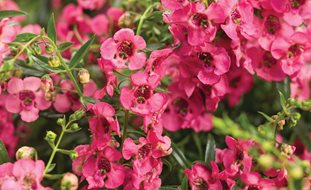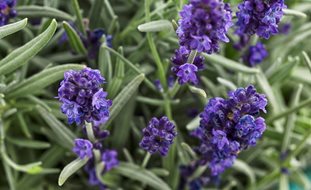How to Grow Annual Sweet Pea Flowers
Bring color and fragrance to your spring garden with these cool-season bloomers.
Spencer sweet peas. Photo by: Andrew Fletcher / Shutterstock.
Deservedly one of the most popular flowering vines, the sweet pea has long been admired for its beguiling fragrance and dainty flowers, in a color palette ranging from pale pastels to richly saturated jewel tones. This old-fashioned favorite thrives in cooler temperatures and will produce an abundance of blooms over a long period, making it a staple in the cutting garden. Even a small bouquet of these enchanting flowers will fill a room with a heavenly scent reminiscent of honey and orange blossoms.
Although most sweet pea plants are tall, fast-growing climbers, you can also find shorter bush varieties that don’t need a trellis for support. Compact and low-growing, they are ideal for use in garden beds, the front of the border, and outdoor container plantings.
On this page: Basics | Planting | Care | Varieties | Frequently Asked Questions
On this page:
- BASICS
- PLANTING SWEET PEAS
- SWEET PEA CARE AND MAINTENANCE
- VARIETIES OF SWEET PEAS
- FREQUENTLY ASKED QUESTIONS
BASICS
Botanical name:
Lathyrus odoratus (means “fragrant pea” in Latin)
Exposure:
Full sun to light shade
Soil:
Prefers moist, well-drained, humus-rich soil with a neutral to alkaline pH.
Height:
Vine-type sweet peas grow 6 to 10 feet tall, while bush types range in height from 8 inches to 3 feet.
Bloom time:
Spring to early summer. In climates with cool summers, plants may continue blooming until fall.
Flower colors and characteristics:
Sweet peas bloom in almost every color except yellow, including shades of pink, red, maroon, purple, lavender, salmon, and white. Some cultivars have bicolored, streaked, or picotee-edged blooms. The flowers are borne in clusters on sturdy stems, with three to six or more flowers per stem.
Special attributes:
- Tolerates light frost
- Deer resistant
- Attracts bees, butterflies, and other pollinators
PLANTING SWEET PEAS
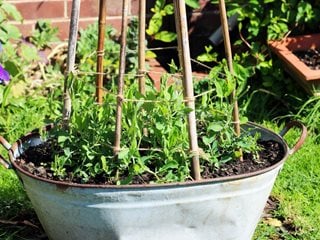
Photo by: Paul Burr / Shutterstock.
Where to plant:
Native to the Mediterranean, sweet peas are happiest when grown in full sun (at least 6 hours daily). In warmer climates, they can benefit from a bit of afternoon shade to help keep them cool.
When to plant:
The secret to success with sweet peas is to plant them early because the seeds must be sown in cool weather. If you live in Zone 8 or warmer, sow seeds in late fall for early spring blooms. In colder climates, sow in early spring as soon as the ground can be worked.
How to plant:
Although you can grow sweet peas from purchased plants, you’ll have a much broader selection of cultivars if you start your plants from seed. Sow the seeds in furrows 1 inch deep, spacing them 2 to 3 inches apart. Water thoroughly, and keep the soil moist until the seeds have sprouted. Expect germination to take 12 to 28 days, depending on the soil temperature.
To improve germination success, nick the hard seed coats with a nail clipper before planting or soak them in water for 24 hours so moisture can penetrate more easily when germinating.
Note: Save your sweet pea seeds! Leave flowers in place until they fade and allow the seed pods to form. Check seed pods often, and harvest them after they turn brown and brittle. You'll want to catch them before they open and drop their seeds, but not too early or the seeds won't germinate. Pop open the seed pods, remove the seeds, and allow them to dry for 2 to 3 days. Then, store them in a cool, dry place for planting next year or in the freezer for at least 5 years.
Starting seeds indoors:
To extend the bloom time of sweet peas, start the seeds indoors 6 to 8 weeks before the last spring frost date. Plant the seeds in biodegradable pots in a soilless all-purpose potting mix, placing two or three seeds in each pot. Keep the soil evenly moist, and place the pots in a brightly lit location or under grow lights. Once the ground thaws and the soil is workable, transplant the pots directly into the garden so you won't disturb the roots. A light frost will not damage newly planted seedlings.
Spacing:
Because sweet peas are susceptible to powdery mildew, sufficient spacing of plants is important for good air circulation. When the seedlings are about 4 inches tall, thin them to a distance of at least 6 inches apart.
Tip:
To create a lattice wall of sweet pea vines, attach some wire mesh, string, or heavy-duty polypropylene netting to vertical stakes spaced several feet apart and allow the tendrils to weave through the grid. As the vines grow, you can secure any stray or wayward shoots to the support using garden twine. It doesn’t take long for sweet peas to climb, so be sure to install your supports at planting time. Learn more: Growing and Arranging Sweet Peas.
SWEET PEA CARE
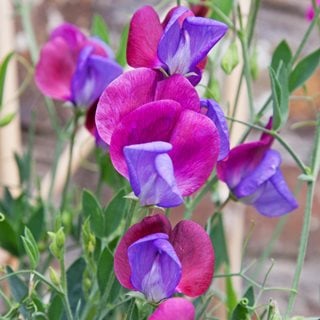
Cupani sweet peas. Photo by: pjhpix / Shutterstock.
Watering:
Sweet pea plants need consistent watering, especially during dry spells. Water plants regularly to keep the soil evenly moist but not soggy, providing about an inch of water a week if rainfall is insufficient. To prevent mildew problems, it’s best to water your plants at soil level or by using a drip irrigation system. Also avoid watering in the late afternoon and evening.
Amendments and fertilizer:
Sweet peas thrive in rich soil, so work in plenty of compost and organic matter before planting. They also need regular fertilization throughout the growing season to keep the blooms coming. Avoid using nitrogen-rich fertilizers, which will promote leaf growth instead of flowering. Instead, use a fertilizer higher in potassium or phosphorus, such as a blend formulated for tomatoes.
Pruning and deadheading:
When young sweet pea plants have developed four to six leaves, pinch back the growing tips by an inch or two to encourage bushier growth with lots of flowering side shoots. Once your sweet peas start blooming, do not let the flowers go to seed. Cut or deadhead them regularly to promote the production of more flowers and keep your plants looking their best. Toward the end of the growing season, you can leave some seedpods on the plant if you want to collect the seeds to sow next year.
Pests and diseases:
Sweet peas can be susceptible to aphids, thrips, garden slugs, and powdery mildew. Birds can also be a threat and may eat tender young seedlings and transplants. To protect your plants, place plastic berry baskets or bird netting over them until they are more mature.
SWEET PEA VARIETIES
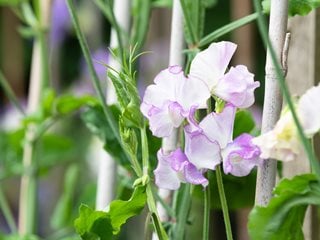
'Sir Jimmy Shand' sweet pea. Photo by: Andrew Fletcher / Shutterstock.
If you shop around for annual sweet peas in seed catalogs or from online vendors, you’ll come across a dizzying array of selections, ranging from modern hybrids to heirloom varieties that have been around for centuries. To help you sort through your options, here’s a look at some of the most common types of sweet peas and the unique attributes of each.
Spencer:
Spencers are valued for their large frilly flowers, long stems, and wide array of colors and patterns, including bicolored, streaked, and picotee varieties. They are considered to be a “summer flowering” sweet pea, which means they need at least 12 hours of daylight in order to bloom. They may perform poorly in warmer climates, where summer temperatures often become too hot before a 12-hour day is reached. One of the most stunning Spencer varieties is ‘Sir Jimmy Shand’, which has creamy white flowers with lilac accents and picotee edges.
Grandiflora:
Among the most fragrant of the sweet peas, grandifloras have plain or slightly wavy petals, rather than the ruffles seen on Spencers. More recent, modern grandiflora hybrids combine the strong fragrance and colorful blooms of the original heirloom types with larger flowers and longer stems, making them wonderful for cutting. Two varieties to try include ‘Almost Black’, which bears masses of highly scented dark maroon flowers, and ‘Erewhon’, a bicolored bloomer with dark lavender-blue and soft pink petals.
Early multiflora:
Sometimes called “winter flowering” sweet peas, these types flower with as few as 10 hours of day length. They are a great choice for warm Southern climates because they can be bought into bloom before summer heat intensifies. Most often sold as part of a series, such as Winter Sunshine and Winter Elegance.
Dwarf and semi-dwarf:
Dwarf and semi-dwarf bush-type sweet peas have a compact habit and are equally at home in window boxes, containers, and garden borders. Dwarf varieties, such as the Cupid series, reach a height of only 8 to 10 inches. Semi-dwarf types (also called “intermediates”) grow to heights of 2 to 3 feet and include cultivars such as 'Explorer' and 'Knee High'.
FREQUENTLY ASKED QUESTIONS
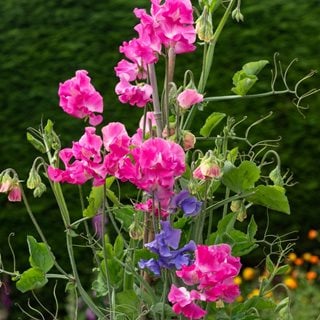
Photo by: Andrew Fletcher / Shutterstock.
Are sweet peas annuals or perennials?
Sweet peas are hardy annuals, which means they can survive cold temperatures and even a touch of frost. They prefer to become established and grow in cool conditions, unlike tender annuals that require heat to grow and thrive.
What is the difference between everlasting peas and sweet peas?
While the common sweet pea is an annual, there is also a perennial or “everlasting pea” (Lathyrus latifolius) that is hardy in zones 4 to 8 and will bloom all summer. This climbing vine bears flowers similar in appearance to those of annual sweet peas, but they have no fragrance.
Are sweet pea plants poisonous?
Although sweet peas are members of the legume family (Fabaceae) they are not edible like garden peas (Pisum sativum). All parts of the plant are toxic to people and pets when ingested, especially the seeds, which can cause a neurotoxic disorder called lathyrism.
How do I harvest sweet pea flowers for the longest vase life?
Pick stems that have at least two unopened flowers at the tip, recommends Erin Benzakein, owner of Floret Flower Farm. Also harvest the blooms in the morning, before they get parched by the sun, and put them directly in a vase of clean water. The more flowers you pick, the more your plants will produce, so keep harvesting them regularly. A bouquet of sweet peas can last as long as a week if you change the water daily.
Why are my sweet pea plants dropping their buds?
This frustrating problem, known as “bud drop,” is not caused by disease and may even afflict plants that appear to be healthy, seemingly overnight. Factors contributing to bud drop include not enough sun exposure, too much nitrogen in the soil, low moisture levels, and dramatic temperature swings. If you notice buds that are starting to turn yellow and then drop off before they fully develop, make sure your plants are receiving at least 6 hours of sunlight daily and keep the soil evenly moist. Also stop fertilizing until the flowers begin to fully form.
What should I do with sweet peas after they have finished flowering?
Sweet pea vines will stop flowering and die back naturally with higher summer temperatures, unless you are growing a heat-tolerant cultivar. Once they do, you can pull up the plants and place them in the compost pile. To take their place, consider planting a heat-loving annual vine, such as black-eyed Susan vine or morning glory.
